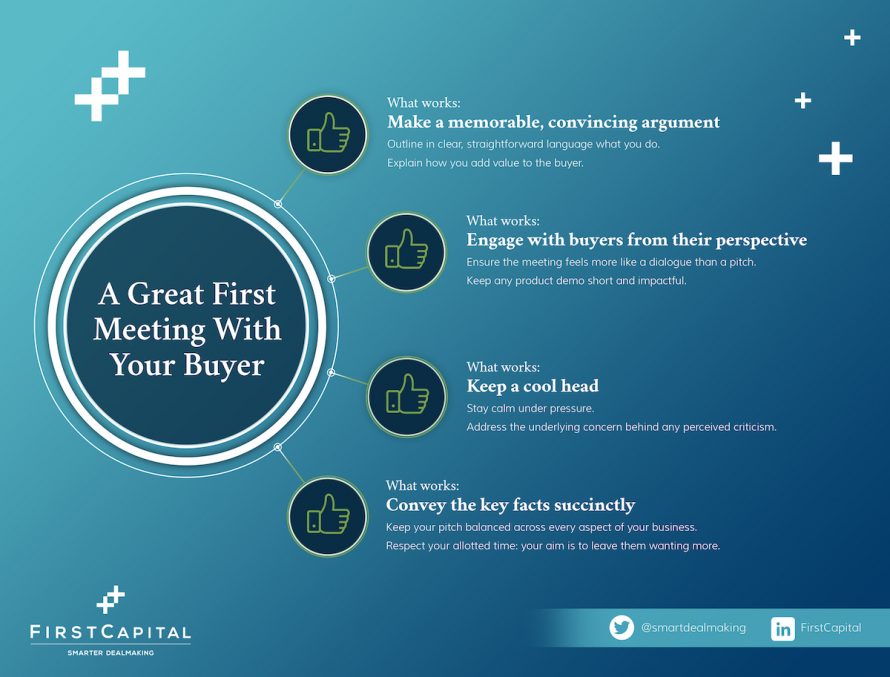Demystifying M&A
Demystifying M&A: What makes a great first meeting with a buyer
10th July 2018
By Jason Purcell
Your first management meeting with a potential buyer can be challenging and stressful. However well prepared you are, you’re not sure what to expect from them and what kind of a reception you will get.
The primary goal of any first meeting is, of course, to get a second meeting. What you say must get them excited and interested enough to make them want to meet with you again to delve deeper.
While, for many, this can be a daunting prospect, actually this takes much of the pressure off. Rather than having the flashiest presentation or the best public speaking skills, you just need to focus on communicating the key messages and sufficient information to capture the buyer’s interest and leave them wanting to know more.
I have been doing deals for more than 20 years and in that time, I’ve come to understand what works and what doesn’t work when securing a second meeting.
What works: A memorable, convincing argument
Explain in clear, straightforward language what you do and why that is important to your buyer. You’ll need to convey the joint opportunity, and how this will make the buyer money or address an unmet need.
The key is to make advocacy easy. It is likely that the person you meet will have to explain what you do to multiple internal stakeholders before they meet you again, so ensure that you are memorable and that you’ve described the business and the opportunity in clear and easy-to-understand language (avoiding jargon).
What doesn’t work: Not engaging with buyers from their perspective
If you’re effectively conveying what your business could do for the buyer, the meeting will feel much more like a dialogue than a pitch.
We tend to find that, with long presentation decks, sellers get distracted or bored. The pitch deck should act as a support for your conversation with the buyer rather than an information broadcast. Including good visuals can be very effective.
In terms of product demos, be cautious of inserting these into a first meeting. If you are spending 45 minutes of an hour-long meeting slot just on a product demo, this leaves no time for buyer dialogue or questions and won’t feel very interactive or engaging. It’s probably something best left to a follow-up, unless it’s really a key part of your story.
What works: Keeping a cool head
Though you probably get on well with your fellow team members, a management meeting adds a unique level of pressure that can make people react in different ways. Buyers will be watching out for team dynamics – how you interact with each other and how you handle questions. Be respectful of everyone’s contributions to the meeting and don’t interrupt your team members when they are talking under any circumstances.
It is important to stay calm and, if necessary, take a couple of seconds before responding to buyer questions if you are likely to reply defensively. Addressing the underlying concern beyond what you might first perceive as criticism will show you can take on challenges appropriately.
Buyers will also be concentrating on non-textual clues like tone of voice and body language. Good eye contact, confidence and composure, even under stress, are key to leaving a good impression with both what you do and don’t say.
What doesn’t: Too much detail
No buyer wants to set through a lengthy, technical product description in a first meeting. You’re likely to only have one hour and you need to respect your allotted time. Your pitch should be balanced across every aspect of your business – without going too deep into the technology or the financials. Remember, your objective is to leave them wanting more.
Everyone on your side must have a part to play in the conversation. Silent observers don’t leave a great impression. If they don’t have a role in the meeting, don’t have them there.
Final observations
The buyer will be wondering whether this is the right deal or company for them and will use the first meeting to decide if it is worth progressing. Buyers want to see commitment to your business and belief in what you’re saying, so show that you are enthusiastic about the company and the potential for joint value creation, as well as that you are capable of delivery.
A great pitch will engage the other side, and get them enthused and interested. It will feel less like broadcasting and more like a dialogue. Good preparation and practice, with support from an experienced adviser, are highly recommended. For more information on building your brand story into your pitch, read The Power of Storytelling in M&A.

